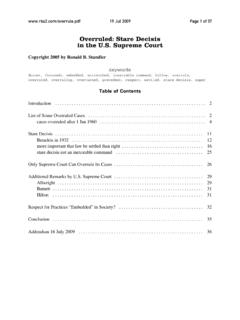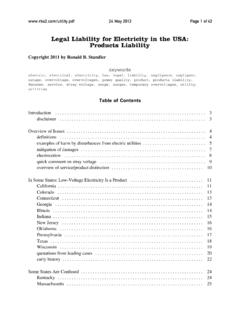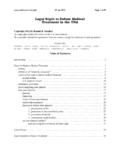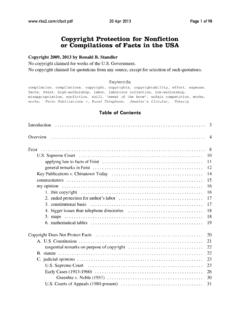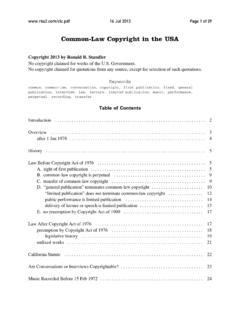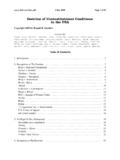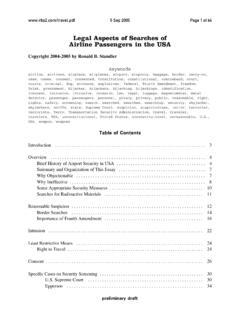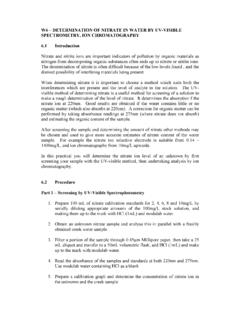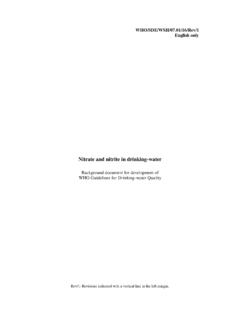Transcription of Statutory Law USA: Requiring Silver Nitrate in Eyes …
1 17 Dec 2006 Page 1 of 25. Statutory Law in the USA: Requiring Silver Nitrate in Eyes of Newborns Copyright 2006 by Ronald B. Standler Table of Contents Introduction .. 2. 1. History of Prophylaxis of Ophthalmia Neonatorum .. 3. side effects of Silver Nitrate .. 3. antibiotics .. 5. iodine .. 7. my conclusion about medical history .. 8. 2. Litigation .. 9. effect of statute on litigation .. 11. 3. Old State Statutes .. 12. 4. November 2006 State Statutes .. 15. my comments .. 23. Conclusion .. 25. 17 Dec 2006 Page 2 of 25. Introduction During childbirth, the eyes of many infants are contaminated with bacteria, which infection . called ophthalmia neonatorum can lead to serious eye damage and even blindness. In the year 1881, it was discovered that a drop of Silver Nitrate (AgNO3) solution put in the eye of newborn infants prevented infection.
2 State legislatures in the USA reacted by passing statutes that required physicians to put a drop of 1% Silver Nitrate solution in each eye of every newborn baby. However, Silver Nitrate is caustic and commonly produces pain and chemical conjunctivitis. This essay is a case study in how these badly written statutes harmed people, by mandating antique therapy, after the late 1940s, when better prophylactic agents were available. In this essay, I argue that it was a mistake for legislators to prescribe specific medical prophylaxis in a statute. Instead, I believe the legislators should have simply required some kind of prophylaxis against ophthalmia neonatorum and given the choice of drug to the attending physician. This essay presents general information about an interesting topic in law, but is not legal advice for your specific problem.
3 See my disclaimer at . Because of limits on my unpaid time and lack of a local major medical library, I have made only a quick search of the medical literature. On 8 Dec 2006, the Medline database lists more than 480 articles in the English language on ophthalmia neonatorum, including its etiology, prophylaxis, and treatment. On the other hand, my search of law review articles in Westlaw databases found nothing on state statutes Requiring Silver Nitrate prophylaxis. 17 Dec 2006 Page 3 of 25. 1. History of Prophylaxis of Ophthalmia Neonatorum During childbirth, the eyes of some infants are contaminated with Neisseria gonorrhea or other bacteria, which infection can lead to serious eye damage and even blindness. In the year 1881, it was discovered that a drop of 2% Silver Nitrate (AgNO3) solution put in the eye of newborn infants prevented gonococcal This landmark discovery decreased the frequency of neonatal blindness by at least a factor of thirty, and was an important advance in public health.
4 During the years 1910-1940, many state legislatures in the USA reacted by passing statutes that required physicians to put a drop of 1% Silver Nitrate solution in each eye of every newborn baby. side effects of Silver Nitrate Silver Nitrate is caustic and routinely produces chemical conjunctivitis. One study published in the year 1958 showed that after 2% solution of Silver Nitrate .. a discharge was present with inflamed eyes or [eye]lids were swollen in 46% of the infants on the first day after instillation of the Silver Nitrate . The incidence decreased steadily through the fifth day .. to 6% .. Peter L. Mathieu, Comparison Study: Silver Nitrate and Oxytetracycline in Newborn Eyes .., . AMA Journal of Diseases of Children, Vol. 95, pp. 609-611 (June 1958) at page 610.
5 The original work of Cred in Leipzig, Germany in 1881 used a 2% solution of Silver Nitrate . Apparently to minimize irritation of the eyes, the practice in the USA during the 1900s often specified in state statutes was to use a 1% solution of Silver Nitrate . There is one published suggestion2 that concentrations of Silver Nitrate as low as could be effective prophylaxis against N. gonorrhoea. One wonders if there was a scientific determination of the minimum effective concentration of Silver Nitrate during the years 1880-1940. Using the weakest possible solution would have minimized pain and conjunctivitis in the newborn infants. The consensus seems to be that chemical conjunctivitis following administration of 1% Silver Nitrate usually disappears in 24 to 36 hours, but sometimes persists up to 72 hours.
6 One study, which found only 10% of Silver Nitrate patients having redness and swelling , reported discharge 1 Karl S. F. Cred , Die Verh tung der Augenentz ndung der Neugeborenen, Archiv f r Gyn kologie, Vol. 17, pp. 50-53 (1881). 2 Hiroshi Nishida and Herman M. Risemberg, Silver Nitrate Ophthalmic Solution and Chemical Conjunctivitis, Pediatrics, Vol. 56, pp. 368-373 (1975), at pp. 370-371. 17 Dec 2006 Page 4 of 25. from the eyes in of Silver Nitrate patients, but only in of patients receiving erythromycin In response to the pain of Silver Nitrate eye drops, newborn infants close their eyes. Because the infant closes both eyes in response to the Silver Nitrate in its first eye, it is difficult to treat the infant's second Several medical studies have concluded that this pain interferes with mother-child The significance of such interference with mother-child bonding is not clear, but seems undesirable.
7 Some maternity wards delay applying the Silver Nitrate prophylaxis until between one and two hours after birth, but this delay could make the prophylaxis less effective. Moreover, temporarily damaged conjunctiva (as shown by the conjunctivitis and discharge). caused by Silver Nitrate may have made the eye more vulnerable to infection after birth. There is a more insidious problem caused by chemical conjunctivitis and discharge after Silver Nitrate prophylaxis. The chemical conjunctivitis and discharge appears similar to an infection, which should be cultured, thus increasing the workload of nurses and bacteriologists, while finding that the patient has no Alternatively, if the physician dismisses the conjunctivitis and discharge as probably a reaction to the Silver Nitrate , then there could be a delay in obtaining cultures and beginning treatment of an active infection.
8 Before the introduction of penicillin in the late 1940s, there was no effective treatment for gonococcal ophthalmia neonatorum, and Silver Nitrate was the only effective prophylaxis, therefore the risk of pain and temporary conjunctivitis was worth the benefit of avoiding corneal scarring and possible blindness from infections. 3 Joseph R. Christian, Comparison of Ocular Reactions with the use of Silver Nitrate and Erythromycin in Ophthalmia Neonatorum Prophylaxis, Journal of Pediatrics, Vol. 57, pp. 55-60. (July 1960), at page 57. 4 Vivian Wahlberg, Reconsideration of Cred Prophylaxis, Acta Paediatrica Scandinavica Supplement, Vol. 295, pp. 1-73 (1982), at page 33. 5 Perry M. Butterfield, Robert N. Emde, Bruce B. Platt, Effects of Silver Nitrate on Initial Visual Behavior, clinical memorandum, American Journal Diseases of Children, Vol.
9 132, p. 426 (April 1978); Perry M. Butterfield, Robert N. Emde, and Marilyn J. Svejda, commentary, Does the Early Application of Silver Nitrate Impair Maternal Attachment? Pediatrics, Vol. 67, pp. 737-738. (May 1981); Vivian Wahlberg, Reconsideration of Cred Prophylaxis, Acta Paediatrica Scandinavica Supplement, Vol. 295, pp. 1-73 (1982), especially at pages 10, 18-19, 45-46, and 49-56. 6 Vivian Wahlberg, Reconsideration of Cred Prophylaxis, Acta Paediatrica Scandinavica Supplement, Vol. 295, pp. 1-73 (1982), at page 33. 17 Dec 2006 Page 5 of 25. antibiotics When antibiotics ( , penicillin, erythromycin, tetracycline) became available in the 1940s and 1950s, there were effective therapies for ophthalmia neonatorum. Some physicians doubted the need to continue routine prophylaxis against ophthalmia neonatorum in every childbirth.
10 Routine prophylaxis at birth was discontinued in the United Kingdom in the late 1950s without any reported cases of blindness from If prophylaxis were to be done, one should use a drug that is less painful and less irritating than Silver Nitrate solution. However, physicians in some states in the USA were forced to continue using caustic Silver Nitrate , only because Silver Nitrate was required by statute, until legislatures amended the statutes. Dr. Lehrfeld in Philadelphia conducted an experiment comparing 1% Silver Nitrate and an aqueous solution of penicillin in 1400 consecutive deliveries during Penicillin was the better prophylactic, in that there were zero cases of ophthalmia neonatorum in infants treated with penicillin vs. five cases in infants treated with Silver Nitrate .
